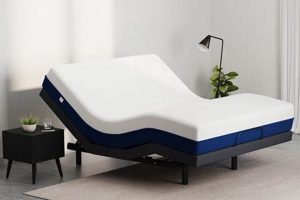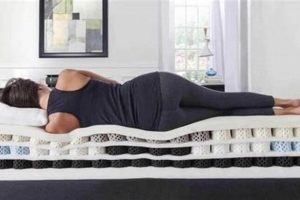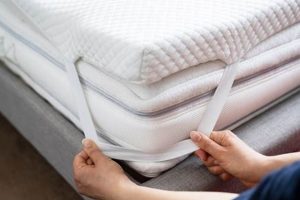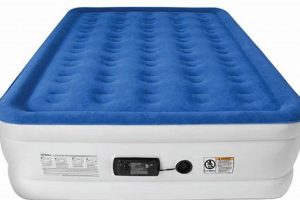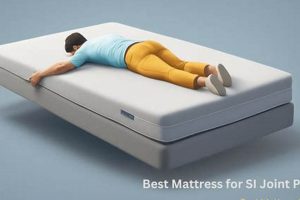The selection of a sleep surface is a critical decision for individuals experiencing discomfort in the hip region. This choice impacts not only sleep quality but also the alleviation of pressure points and the promotion of proper spinal alignment, factors directly influencing the level of pain experienced. For example, a surface that conforms excessively may exacerbate discomfort, while one that is too firm may fail to provide adequate support and pressure relief.
The appropriate sleep surface offers substantial benefits. Individuals may experience reduced pain levels, improved sleep duration and quality, and enhanced overall physical well-being. Historically, individuals have relied on various materials for bedding, ranging from natural fibers to rudimentary padding. Modern technology has introduced a wide array of advanced materials and construction techniques designed to address specific needs, including those of individuals with hip pain.
Understanding the factors that contribute to hip pain during sleep, as well as the various mattress types and features available, is essential for making an informed decision. This necessitates exploring materials, construction, firmness levels, and specific considerations for different sleeping positions to determine the optimal sleep surface.
Guidance on Selecting a Suitable Sleep Surface for Hip Pain
The following guidelines are intended to assist individuals in making informed decisions when choosing a sleep surface to mitigate hip pain. Consideration of these factors can contribute to improved sleep quality and reduced discomfort.
Tip 1: Prioritize Pressure Relief: Focus on mattresses with materials that effectively contour to the body and alleviate pressure on sensitive areas, particularly the hips. Memory foam and latex are common choices known for their pressure-relieving properties.
Tip 2: Evaluate Firmness Level: Determine the appropriate firmness level based on sleeping position and body weight. Side sleepers typically benefit from a softer to medium-firm mattress, while back sleepers may prefer a medium-firm to firm option. A firmness level that neither sags excessively nor is overly rigid is ideal.
Tip 3: Consider Spinal Alignment: Ensure the chosen mattress supports proper spinal alignment. A mattress that allows the spine to maintain its natural curvature can reduce strain on the hips and lower back.
Tip 4: Investigate Layer Construction: Pay attention to the layers within the mattress. A combination of supportive base layers and comfort layers designed for pressure relief can provide optimal support and cushioning.
Tip 5: Research Mattress Type: Familiarize oneself with different mattress types, including memory foam, latex, innerspring, and hybrid models. Each type offers distinct characteristics and may be better suited to individual needs.
Tip 6: Read Reviews and Seek Recommendations: Consult reviews from individuals with similar conditions and seek recommendations from healthcare professionals. Real-world experiences and expert opinions can provide valuable insights.
Tip 7: Trial Period Utilization: Take advantage of trial periods offered by mattress retailers. This allows for an extended period to assess the suitability of the mattress and ensure it meets individual needs.
Selecting a sleep surface that effectively addresses pressure relief, spinal alignment, and firmness requirements is crucial for managing hip pain and promoting restful sleep. Careful consideration of these guidelines can lead to improved comfort and reduced discomfort.
The subsequent sections will delve into specific mattress types and their suitability for individuals experiencing hip pain, further aiding in the selection process.
1. Pressure Relief
Effective pressure relief is a crucial component in selecting a sleep surface suitable for individuals experiencing hip pain. The connection between these two elements is direct: a mattress that fails to adequately distribute weight and alleviate pressure on the hip joints can exacerbate existing pain and impede restorative sleep. Conversely, a mattress engineered to provide targeted pressure relief can significantly reduce discomfort and promote healing.
The principle of pressure relief hinges on the mattress’s ability to conform to the body’s contours, minimizing concentrated stress on bony prominences, such as the hips. Materials like memory foam and latex are frequently employed due to their inherent viscoelastic properties. Consider, for instance, an individual with bursitis of the hip. A conventional innerspring mattress, with its lack of conforming capabilities, may exert undue pressure on the affected bursa, leading to increased inflammation and pain. In contrast, a memory foam mattress would distribute the individual’s weight more evenly, reducing stress on the bursa and allowing for more comfortable sleep. The practical significance of understanding this connection lies in the ability to make informed decisions about mattress selection, prioritizing materials and construction methods designed to alleviate pressure.
In summary, the connection between pressure relief and the suitability of a mattress for hip pain is undeniable. Failure to prioritize this aspect can perpetuate discomfort, while a focus on pressure-relieving properties can contribute to improved sleep quality and reduced pain. Selecting a mattress that effectively conforms to the body’s contours and minimizes stress on the hip joints is a fundamental step in managing hip pain during sleep.
2. Spinal Alignment
Proper spinal alignment is a critical determinant in the effectiveness of a sleep surface for individuals with hip pain. The skeletal structure, when correctly aligned, minimizes stress on joints and surrounding soft tissues. Conversely, misalignment can exacerbate existing conditions and contribute to the development of new musculoskeletal issues. A sleep surface that fails to support the natural curvature of the spine can place undue pressure on the hips, leading to increased pain and discomfort. For example, a mattress that is too soft may allow the hips to sink excessively, creating a bend in the spine and compressing the hip joints. Conversely, an overly firm mattress may fail to conform to the body’s contours, preventing the spine from resting in its natural alignment and placing strain on the hips.
The significance of spinal alignment extends beyond mere comfort; it impacts overall biomechanics. Maintaining a neutral spine during sleep facilitates optimal muscle relaxation and reduces the likelihood of nerve compression. Furthermore, proper alignment promotes efficient circulation and lymphatic drainage, which are essential for tissue repair and reducing inflammation. Selecting a mattress that is appropriate for an individual’s sleeping position and body type is crucial for achiev
ing optimal spinal alignment. Side sleepers, for instance, typically require a mattress with sufficient give to accommodate the shoulders and hips, while back sleepers often benefit from a firmer surface that supports the natural arch of the lower back. The practical application of this knowledge involves careful consideration of mattress firmness, material composition, and support structure to ensure the spine remains properly aligned throughout the night.
In summary, spinal alignment is inextricably linked to the effectiveness of a sleep surface for mitigating hip pain. Prioritizing spinal alignment through informed mattress selection can lead to reduced pain, improved sleep quality, and enhanced musculoskeletal health. The challenges lie in identifying the specific mattress characteristics that best support an individual’s unique needs and sleeping preferences. However, a thorough understanding of the principles of spinal alignment can empower individuals to make informed decisions and improve their overall well-being.
3. Firmness Level
Firmness level is a critical determinant in the suitability of a mattress for individuals experiencing hip pain. The interaction between mattress firmness and the individual’s anatomy dictates the degree of support, pressure relief, and spinal alignment achieved, directly influencing comfort and pain levels.
- Impact on Pressure Distribution
Mattress firmness dictates how weight is distributed across the sleep surface. A too-firm mattress may create pressure points on the hips, while a too-soft mattress may lack adequate support, leading to sinking and spinal misalignment. Finding the optimal firmness allows for even weight distribution, minimizing stress on the hip joints. For example, a medium-firm mattress might be suitable for a side sleeper, providing both cushioning and support to maintain spinal alignment and reduce pressure on the hips.
- Influence on Spinal Alignment
The relationship between firmness and spinal alignment is crucial for managing hip pain. The sleep surface must allow the spine to maintain its natural curvature. A mattress that is either too firm or too soft can force the spine into an unnatural position, exacerbating existing hip problems. Proper spinal alignment promotes muscle relaxation and reduces the likelihood of nerve compression, contributing to reduced pain and improved sleep quality.
- Consideration of Sleeping Position
Preferred sleeping position significantly impacts the ideal firmness level. Side sleepers often benefit from a softer mattress that allows the hips and shoulders to sink slightly, maintaining spinal alignment. Back sleepers may prefer a medium-firm mattress that provides sufficient support without allowing the hips to sink excessively. Stomach sleepers typically require a firmer mattress to prevent excessive arching of the back. Understanding these positional needs is paramount in selecting the appropriate firmness.
- Impact of Body Weight
Body weight also plays a role in determining the optimal firmness level. Individuals with higher body weights may require a firmer mattress to provide adequate support and prevent excessive sinking. Conversely, individuals with lower body weights may find a softer mattress more comfortable. This is because the same mattress will feel firmer to a lighter person and softer to a heavier person. The interplay of body weight and firmness must be considered for proper support and pressure relief.
In summary, firmness level is a pivotal factor in the selection of a suitable sleep surface for mitigating hip pain. Optimal firmness promotes pressure distribution, maintains spinal alignment, accommodates sleeping position, and supports body weight appropriately. Failure to consider these factors can result in increased pain and discomfort, while a thoughtful approach can lead to improved sleep and reduced hip pain.
4. Material Composition
The selection of materials comprising a mattress significantly influences its suitability for individuals with hip pain. This connection stems from the material’s inherent properties, which directly impact support, pressure relief, temperature regulation, and durability all crucial factors in mitigating discomfort. For instance, memory foam, composed of viscoelastic polyurethane, excels at conforming to body contours, distributing weight evenly, and reducing pressure points. Latex, derived from rubber trees, offers similar pressure relief but possesses greater responsiveness and breathability. Conversely, traditional innerspring mattresses, while providing robust support, may lack the conforming properties necessary to alleviate hip pain effectively, particularly for side sleepers where concentrated pressure is exerted on the hip joint. The causal relationship is clear: material composition determines the mattress’s physical properties, which, in turn, dictate its ability to address hip pain.
Hybrid mattresses, which combine multiple materials such as coils and foam layers, attempt to leverage the strengths of different materials. A hybrid may incorporate a pocketed coil system for support and a memory foam or latex comfort layer for pressure relief. However, the effectiveness of a hybrid depends heavily on the quality and arrangement of the component materials. For example, a hybrid with a thin, low-density foam layer may fail to provide adequate pressure relief, rendering it unsuitable despite the presence of supportive coils. The practical significance of understanding material composition extends to evaluating certifications and material sourcing. Certifications such as CertiPUR-US ensure that foams meet specific standards for emissions, content, and durability, informing consumers about the potential health and environmental impacts of their mattress choice.
In summary, material composition is a fundamental determinant of a mattress’s ability to alleviate hip pain. Materials such as memory foam and latex offer superior pressure relief compared to traditional innerspring systems, while hybrid mattresses aim to balance support and comfort through a combination of materials. Ultimately, selecting a mattress with materials tailored to individual needs, considering factors such as pressure relief, breathability, and durability, is essential for managing hip pain and promoting restful sleep. The challenge lies in navigating the diverse array of materials and constructions available, requiring a thorough understanding of their respective properties and potential benefits.
5. Sleeping Position
Sleeping position is a significant determinant in the selection of an appropriate mattress for individuals with hip pain. The orientation of the body during sleep influences pressure distribution, spinal alignment, and overall comfort. Consequently, the optimal mattress characteristics vary depending on whether one primarily sleeps on their side, back, or stomach.
- Side Sleeping and Pressure Relief
Side sleeping concentrates pressure on the hips and shoulders. Mattresses designed for side sleepers typically feature softer comfort layers to allow these areas to sink slightly, promoting spinal alignment
and reducing pressure points. A mattress lacking sufficient cushioning in these areas may exacerbate hip pain for side sleepers. For example, a firm innerspring mattress may not conform adequately to the contours of the hips, leading to increased pressure and discomfort. Choosing a mattress with pressure-relieving materials like memory foam or latex is often recommended for side sleepers with hip pain. - Back Sleeping and Spinal Support
Back sleeping requires a balance of support and contouring to maintain the natural curvature of the spine. A mattress that is too soft may allow the hips to sink excessively, leading to lower back pain, while a mattress that is too firm may not provide adequate support for the lumbar region. A medium-firm mattress is often preferred for back sleepers, as it provides both support and pressure relief. The goal is to maintain spinal alignment and distribute weight evenly, minimizing strain on the hips. Mattresses with targeted lumbar support can further enhance comfort and reduce pain for back sleepers.
- Stomach Sleeping and Spinal Alignment
Stomach sleeping is generally discouraged for individuals with hip pain due to the tendency to arch the back and misalign the spine. However, if stomach sleeping is unavoidable, a firmer mattress is typically recommended to prevent excessive sinking of the hips and lower back. A soft mattress can exacerbate spinal misalignment and increase pressure on the hip joints. Although modifying the sleeping position is often advised, selecting a firmer mattress can help minimize the potential for pain and discomfort for stomach sleepers.
- Combination Sleeping and Versatility
Many individuals shift positions throughout the night, transitioning between side, back, and stomach sleeping. In such cases, a mattress that offers a balance of support and pressure relief is ideal. Hybrid mattresses, which combine the support of innerspring coils with the contouring of memory foam or latex, can be a suitable option for combination sleepers. The mattress should provide adequate support in all sleeping positions while minimizing pressure points on the hips and shoulders. A medium-firm mattress with responsive materials can adapt to different sleeping positions and provide consistent comfort.
In conclusion, the selection of a mattress tailored to the individual’s primary sleeping position is crucial for managing hip pain. Side sleepers require pressure relief, back sleepers need spinal support, and stomach sleepers benefit from a firmer surface. Understanding these positional needs and selecting a mattress accordingly can significantly improve sleep quality and reduce hip pain.
6. Edge Support
Edge support is a crucial consideration when evaluating mattresses, particularly for individuals seeking relief from hip pain. The structural integrity of a mattress’s perimeter directly impacts accessibility, usable surface area, and overall stability, all of which can either alleviate or exacerbate discomfort.
- Reduced Sagging and Enhanced Accessibility
Adequate edge support minimizes sagging along the mattress perimeter. This is especially important for individuals with hip pain who may experience difficulty getting in and out of bed. A stable edge provides a firm surface to push against, reducing strain on the hips and lower back during ingress and egress. Mattresses lacking robust edge support can cause individuals to sink when sitting on the edge, further stressing the hip joints.
- Expanded Usable Surface Area
Effective edge support maximizes the usable surface area of the mattress. Individuals with hip pain may require more space to find a comfortable sleeping position. A mattress with strong edge support allows them to utilize the entire surface without feeling as though they will roll off. This expanded space provides greater freedom of movement and reduces the likelihood of inadvertently putting pressure on painful hip joints.
- Improved Stability and Weight Distribution
Edge support contributes to overall mattress stability and weight distribution. By reinforcing the perimeter, it prevents the mattress from feeling unstable or uneven, especially when multiple individuals are sharing the bed. This stability is crucial for maintaining proper spinal alignment and reducing strain on the hips. A mattress with poor edge support may cause uneven weight distribution, leading to increased pressure on certain areas and exacerbating hip pain.
In conclusion, edge support is inextricably linked to the suitability of a mattress for individuals seeking relief from hip pain. By reducing sagging, expanding usable surface area, and improving stability, it enhances accessibility, comfort, and overall support. Selecting a mattress with robust edge support is a practical consideration that can contribute to improved sleep quality and reduced hip pain.
7. Heat dissipation
Effective heat dissipation is a significant factor in the suitability of a mattress for individuals with hip pain. The body’s ability to regulate temperature during sleep directly impacts comfort and, consequently, pain perception. A mattress that retains heat can create a microclimate of elevated temperature and humidity, disrupting sleep cycles and potentially exacerbating inflammation. For example, individuals with inflammatory conditions affecting the hip joint, such as arthritis or bursitis, may experience increased pain and stiffness in a warm environment. Therefore, a mattress’s capacity to dissipate heat becomes a crucial aspect in managing discomfort.
Mattress materials play a key role in heat dissipation. Traditional memory foam, while offering pressure relief, is often criticized for its tendency to trap heat. In contrast, latex, particularly Dunlop latex, exhibits greater breathability due to its open-cell structure. Innovations in mattress technology have also led to the development of gel-infused memory foam and open-cell memory foam, designed to improve airflow and reduce heat retention. Additionally, mattress covers made from natural fibers like cotton or Tencel can enhance breathability and wick away moisture, further contributing to temperature regulation. Practical applications include selecting a mattress with cooling features, such as a breathable cover and temperature-regulating materials, to create a more comfortable sleep environment. Individuals can also consider using breathable bedding, such as cotton or linen sheets, to further enhance heat dissipation.
In summary, heat dissipation is a critical element in the selection of a mattress suitable for individuals with hip pain. A mattress’s ability to regulate temperature directly impacts comfort, sleep quality, and inflammation levels. Prioritizing mattresses with breathable materials and cooling technologies can contribute to improved sleep and reduced discomfort. The challenge lies in identifying the specific combination of materials and features that best address individual needs and preferences. However, an understanding of the principles of heat dissipation can empower individuals to make informed decisions and improve their overall well-being.
Frequently Asked Questions
This section addresses common inquiries concerning the selection and utilization of mattresses intended to alleviate hip pain. Understanding these points facilitates informed decision-mak
ing and optimizes the potential benefits.
Question 1: Can a mattress truly alleviate hip pain, or is it merely a temporary solution?
A mattress engineered to provide adequate support, pressure relief, and spinal alignment can significantly reduce hip pain and improve sleep quality. While it addresses a primary source of discomfort, it may not resolve underlying medical conditions. Consultation with a healthcare professional is recommended for comprehensive treatment.
Question 2: What mattress type is universally recommended for all individuals experiencing hip pain?
No single mattress type suits all individuals. Optimal mattress selection depends on factors such as sleeping position, body weight, and personal preferences. Memory foam, latex, and hybrid mattresses are frequently recommended due to their pressure-relieving properties, but individual needs vary significantly.
Question 3: How frequently should a mattress be replaced to maintain its effectiveness in alleviating hip pain?
Mattress lifespan varies depending on quality, materials, and usage. Generally, a mattress should be replaced every 7 to 10 years. Signs of wear, such as sagging, reduced support, and increased discomfort, indicate the need for replacement. Regular inspection and maintenance can extend the mattress’s lifespan.
Question 4: Are expensive mattresses always superior in providing relief from hip pain?
Price does not guarantee effectiveness. While higher-priced mattresses may incorporate advanced materials and construction techniques, the suitability for alleviating hip pain depends on individual needs. Thorough research, review of specifications, and trial periods are crucial regardless of price point.
Question 5: Can a mattress topper effectively substitute for a new mattress in alleviating hip pain?
A mattress topper can provide a temporary solution for improving comfort and pressure relief. However, it cannot compensate for a fundamentally unsupportive or worn-out mattress. If the underlying mattress lacks adequate support, a topper may offer limited or no benefit. A new mattress is often necessary for optimal long-term relief.
Question 6: How does sleeping position influence the choice of a mattress for hip pain?
Sleeping position significantly impacts mattress selection. Side sleepers typically benefit from softer mattresses that conform to the hips and shoulders. Back sleepers often prefer medium-firm mattresses for spinal support. Stomach sleepers may require firmer mattresses to prevent excessive spinal curvature. Aligning mattress characteristics with sleeping position is essential for maximizing comfort and reducing hip pain.
Selecting the appropriate mattress for hip pain requires careful consideration of various factors, including mattress type, firmness level, sleeping position, and individual needs. Consulting healthcare professionals and utilizing trial periods can further enhance the decision-making process.
The following section will offer specific product recommendations to ease choosing which mattress to buy.
Concluding Remarks on Selecting a Sleep Surface for Hip Pain Mitigation
The preceding exploration elucidates the complex relationship between sleep surface characteristics and the alleviation of hip pain. Key considerations include pressure relief, spinal alignment, firmness level, material composition, sleeping position, edge support, and heat dissipation. Careful assessment of these factors is paramount in selecting a mattress that effectively addresses individual needs and promotes restorative sleep. The information presented underscores the importance of aligning mattress properties with specific anatomical and physiological requirements to optimize comfort and minimize discomfort.
Given the significant impact of sleep quality on overall well-being, individuals experiencing hip pain are encouraged to approach mattress selection with diligence. Consulting healthcare professionals, conducting thorough research, and utilizing trial periods are essential steps in identifying a sleep surface that provides optimal support and pressure relief. Prioritizing informed decision-making can lead to substantial improvements in sleep quality and a reduction in chronic hip pain, ultimately enhancing the individual’s quality of life.


![Top-Rated Best Mattress for Pack N Play - [Year] Review Organic & Natural Mattress Buyer’s Guide: Non-Toxic Sleep Solutions Top-Rated Best Mattress for Pack N Play - [Year] Review | Organic & Natural Mattress Buyer’s Guide: Non-Toxic Sleep Solutions](https://mattressworldpa.com/wp-content/uploads/2025/07/th-7612-300x200.jpg)
